Supplemental digital content is available in the text.
Key Words: acute pancreatitis, complications, diabetes mellitus, mortality, length of hospitalization
Abstract
The prevalence of diabetes mellitus (DM) and acute pancreatitis (AP) increases continuously, therefore, to understand the effects of preexisting diabetes on AP is crucially needed. Here, we performed a systematic review and meta-analysis in which AP patients including DM and non-DM groups were sorted. Several outcome parameters were analyzed, and the odds ratio (OR) and standardized mean difference with 95% confidence intervals (CIs) were calculated.
We found 1417 articles, of which 9 articles involving 354,880 patients were analyzed. More complications were seen in diabetic patients than in non-DM patients (OR, 1.553 [95% CI, 1.266–1.904]; P < 0.001). Intensive care unit admission (OR, 1.799 [95% CI, 1.442–2.243]; P < 0.001) and renal failure (OR, 1.585 [95% CI, 1.278–1.966]; P < 0.001) were more frequent in DM patients. There was a tendency of higher mortality and local complications (OR, 1.276 [95% CI, 0.991–1.643]; P = 0.059; and OR, 1.267 [95% CI, 0.964–1.659]; P = 0.090, respectively) in preexisting DM. Length of hospitalization was longer in DM patients (standardized mean difference, 0.217 [95% CI, 0.075–0.360]; P = 0.003). Preexisting DM negatively influences the outcome of AP and increases the risk of renal failure, local complications, and mortality.
Acute pancreatitis (AP) is a severe inflammatory condition with increasing incidence and hospitalization worldwide.1,2 Acute pancreatitis has a variable severity ranging from mild and self-limited to severe and fatal. The mortality of the disease ranges approximately from 2 to 5% and depends on the development of organ failure and local complications, which are summarized in the revised 2012 Atlanta classification.3 The major etiological factors are gallstones and alcohol intake,1 but hypertriglyceridemia and intake of certain medications may also be present in the background.
The global prevalence of diabetes among adults doubled between 1980 and 2014.4 The relationship between AP and diabetes mellitus (DM) is complex. Acute pancreatitis may result in DM.5 On the other hand, patients with type 2 (T2) DM had an elevated risk of AP,6–10 and the risk of AP in diabetic patients can be reduced with appropriate glycemic control.11 Furthermore, DM patients tend to develop hypertriglyceridemia and gallstones, both of which may lead to AP.12,13 Hyperglycemia was demonstrated to be closely correlated with poor outcomes of morbidity and mortality in critically ill patients.14 Many patients with T2DM have comorbid conditions (eg, heart failure, renal disease, liver disease, and obesity), which may increase the risk of severe AP and can be strong predictors of early death from AP.15,16 Moreover, diabetic comorbidities require the use of medications that have been associated with pancreatitis. Incretin use in the treatment of T2DM has been investigated in several meta-analyses of the risk of AP.17–21
Experimental studies clearly suggest that preexisting diabetes deteriorates the outcome of AP. Zechner et al22 showed that diabetes significantly raises the plasma interleukin 6 concentration and further reduces the number of lymphocytes during AP; diabetes thus exacerbates pancreatitis-induced systemic inflammation. Other studies have also demonstrated that diabetes increases pancreatic fibrosis23,24 and decreases pancreatic regeneration.25–27 Importantly, cholecystokinin-promoted pancreatic regeneration was also impaired in diabetic rats after the induction of experimental pancreatitis.28
Unfortunately, little human data are available on the effect of preexisting DM or the complications of AP. No systematic reviews or meta-analyses are available to summarize our knowledge of the effects of preexisting diabetes on the outcome of AP.
In this study, we therefore aimed to demonstrate the influence of preexisting DM on the outcomes of AP, including mortality, length of hospitalization (LOH), incidence of organ failure, and intensive care unit (ICU) admission in a large number of patients by using detailed meta-analyses of the data available in the literature.
MATERIALS AND METHODS
Search Strategy
This study was conducted according to the principles in the Preferred Reporting Items for Systematic Reviews and Meta-Analyses) statement29 (Supplementary Table 1, http://links.lww.com/MPA/A663) and was registered in the PROSPERO registry (under registration number CRD42016053207). Our meta-analysis was based on the patient, intervention, comparison, and outcome (PICO) format (P, patients suffering from AP; I, diabetic patients; C, nondiabetic patients; O, mortality, LOH, organ failure, ICU admission). A systematic search was made in 3 databases, Pubmed, Embase, and the Cochrane Library, using the following terms: acute pancreatitis and diabetes mellitus. The search was limited to human data and to full-text English articles. The exact search terms in Pubmed were as follows: (acute[all fields] and (pancreatitis[MeSH terms] or pancreatitis[all fields])) and (diabetes mellitus[MeSH terms] or (diabetes[all fields] and mellitus[all fields]) or diabetes mellitus[all fields]) and (humans[MeSH terms] and English[lang]). The database search was conducted up to March 8, 2017. The duplicates were removed using the EndNote X7 reference manager software (Clarivate Analytics, Philadelphia, Penn).
Study Selection
The studies were selected separately by two investigators (A.M. and L.C.). Disagreements were resolved by consulting a third reviewer (P.H.). Clinical studies were eligible provided that they reported the data for adult patients suffering from AP separately for diabetic and nondiabetic patients. Information on the outcome of pancreatitis (mortality, organ failure, LOH, and admission to ICU) was searched for manually (Supplementary Table 2, http://links.lww.com/MPA/A663). The reference lists in the articles obtained were also checked, but no additional eligible articles were found.
Data Extraction
For statistical analysis, mortality data were calculated by number of patients30,31; local complications32 and renal failure data33 were expressed as percentages. The data for Supplementary Table 2 (http://links.lww.com/MPA/A663) from Mole et al34 were computed, and the percentage for ICU admission was calculated for the DM and non-DM groups. Kikuta et al30 presented graphs on organ failures in DM and non-DM groups each day in the first 72 hours. These data were confirmed by the investigators, and an average value was calculated from data for 3 days. Nawaz et al35 only presented the median for LOH. The interquartile range for these data was requested for statistical analysis.
The basic characteristics of the 9 eligible articles included in the meta-analysis are shown in Table 1.
TABLE 1.
Description of the Studies Included in the Meta-analysis
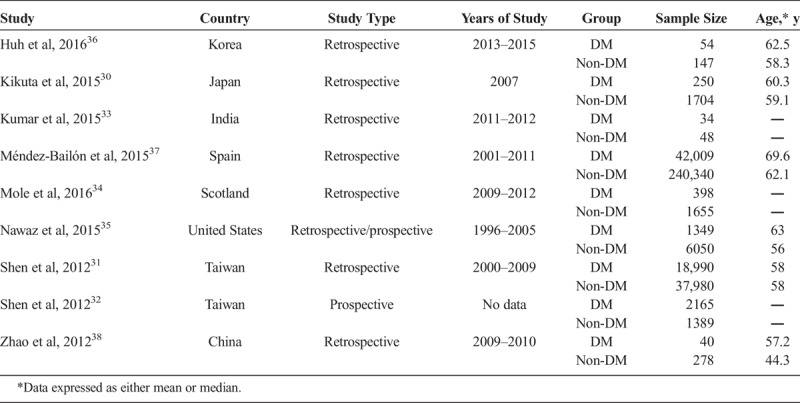
Data Synthesis and Analysis
All meta-analysis calculations were made with Comprehensive Meta-Analysis software version 3 (Biostat, Inc., Englewood, NJ) using the random effects model (DerSimonian-Laird method39). Odds ratios (OR) and 95% confidence intervals (CIs) were calculated for binary outcomes. In the case of LOH, standardized mean difference with 95% CI was calculated to compare mean data. We used the conversion method by Hozo et al40 because only the median and interquartile range were provided in some studies.31,35,37 All analyses were 2-tailed, with an α value of 0.05.
Heterogeneity was tested using Cochrane Q and I2 statistics. Based on the Cochrane Handbook, I2 = 100% × (Q − df)/Q represents the magnitude of the heterogeneity (moderate, 30%–60%; substantial, 50%–90%; considerable, 75%–100%).41
The results from 4 or more studies were displayed graphically using forest plots. These outcomes are mortality, LOH, and complications. Results were also weighted based on the number of patients studied in the articles. To assess required information size and to estimate the robustness of our conclusions, we conducted a trial sequential analysis (TSA; with TSA tool from Copenhagen Trial Unit, Center for Clinical Intervention Research, Denmark; version 0.9 beta, www.ctu.dk/tsa) and a sensitivity analysis. The required information size calculation was based on the assumption of a 10% relative risk reduction, and we adjusted all analysis for heterogeneity (diversity adjustment). The TSA monitoring boundaries were built based on a risk for a type I error of 5% and a type II error of 20%. If a TSA monitoring boundary is crossed with a Z-curve before the required information size is reached, robust evidence might have been confirmed and further trials are unnecessary. Therefore, more trials are needed in this field. With sensitivity analysis, we can assess whether altering any of the assumptions may lead to different final interpretations or conclusions.42
Quality of Studies and Risk of Bias
Because of the low number of articles, publication bias was obtained by visual inspection of the funnel plots. The Newcastle-Ottawa scale43 was used for a quality assessment of nonrandomized cohort studies. The selection, comparability, and outcome data were assessed with the star system based on 7 items (Supplementary Tables 3–4, http://links.lww.com/MPA/A663): high-quality items carrying a low risk of bias were assigned one star, whereas low-quality items carrying a high or unknown risk of bias received no stars. Selection consisted of 4 items, with articles earning 2 stars for comparability and only adequacy of follow-up being rated at outcome. Assessment of outcome and length of follow-up were not rated because most of the articles were retrospective. We assigned a star for responsiveness of study population if all of the AP patients with or without DM were included, but no stars were given whenever selection criteria were applied. Low risk of bias was assessed if AP diagnosis was ascertained by 2 of 3 criteria (elevation of serum amylase and/or lipase activity at least 3 times higher than the upper normal limit, presence of abdominal pain, and inflammation detected with abdominal ultrasound and/or computed tomography) and if the standard definition of preexisting DM was applied, whereas the inclusion of newly diagnosed DM based on elevated HbA1c was also acceptable.44 Diabetes mellitus and non-DM patients were compared based on age and body mass index because the negative influence of obesity is well known in AP patients.45 If there was a follow-up, the adequate number of patients was screened for complications.
RESULTS
Study Selection
Database searches produced a total of 1417 articles (Embase, 759; PubMed, 590; Cochrane, 68). The flow chart diagram (Fig. 1) shows the strategy for article selection. Studies used in our meta-analysis were dated from 1948 to March 2017. After removal of duplicates, 1119 unique records remained. Following initial screening based on titles and abstracts, case reports and records with data on children were excluded; 52 articles were finally retrieved and screened. A further 43 articles were excluded: 34 because the main outcome was the risk of development of AP, 5 because of the inappropriate classification of values (there were no DM and non-DM groups), 1 by reason of missing numerical outcome data, 2 with only late outcome data (pancreatic exocrine or endocrine insufficiency), and 1 in which not all of the patients had AP. The remaining 930–38 articles were included in the meta-analysis (Table 1). They consisted of 354,880 patients, 65,289 of whom had preexisting DM as a comorbidity.
FIGURE 1.
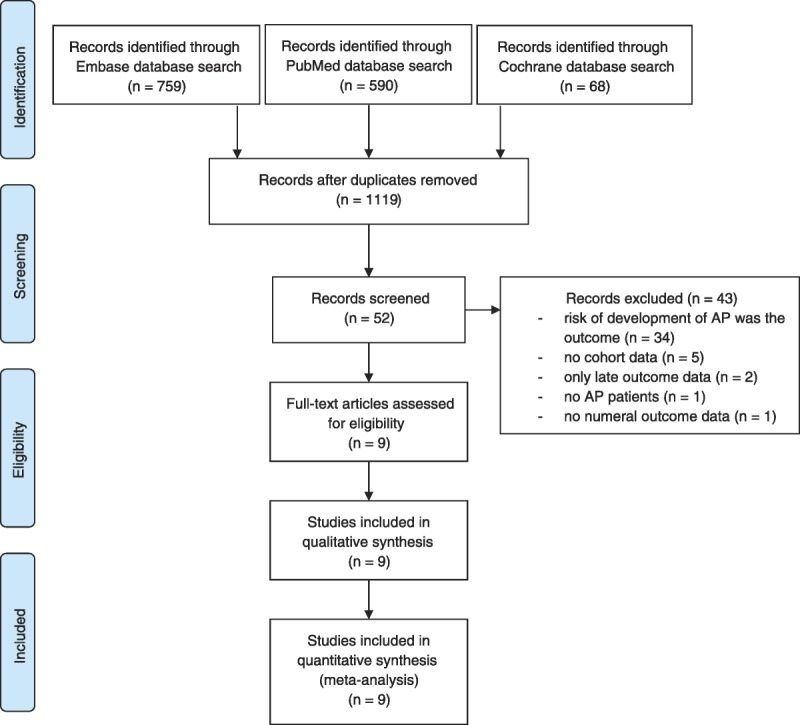
Flowchart for the study selection procedure.
Complications
The rate of complications in the 2 AP groups was analyzed first. Overall, based on 7 articles, more complications were seen in DM patients than in non-DM patients (OR, 1.553 [95% CI, 1.266–1.904]; P < 0.001) (Fig. 2).
FIGURE 2.
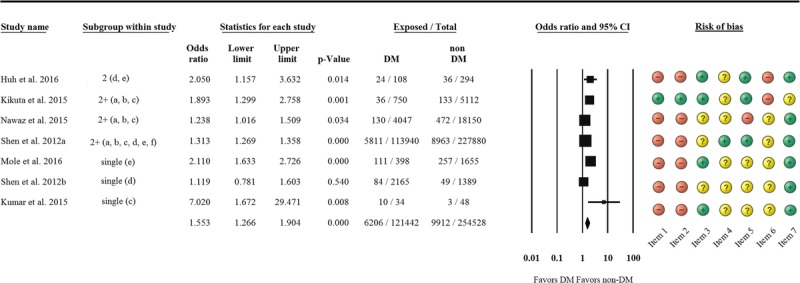
Forest plot representing the differences in complications in DM and non-DM patients suffering from AP. Size of squares for risk ratio reflects weight of trial in pooled analysis. Horizontal bars represent 95% CIs. Single, only 1 complication is available; 2+, more complications are available; a, cardiovascular; b, respiratory; c, renal; d, local; e, intensive care unit admission; f, neurological.
A subgroup analysis was conducted to detect which types of complications are most frequent in DM. In the case of preexisting DM, significantly more ICU admissions (OR, 1.799 [95% CI, 1.442–2.243]; P < 0.001) and renal failure (OR, 1.585 [95% CI, 1.278–1.966]; P < 0.001) were seen than in non-DM patients. Diabetic patients more often develop local complications (OR, 1.276 [95% CI, 0.991–1.643]; P = 0.059), but the difference did not reach statistical significance. No differences were found in cardiovascular (OR, 0.942 [95% CI, 0.722–1.23]; P = 0.661), neurological, and respiratory complications (OR, 1.060 [95% CI, 0.833–1.349]; P = 0.636) (Fig. 3).
FIGURE 3.
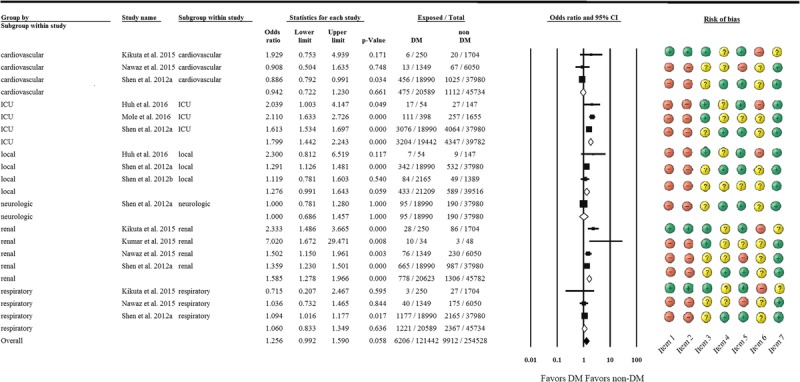
Forest plot representing detailed differences in several types of complications in DM and non-DM patients suffering from AP. Size of squares for risk ratio reflects weight of trial in pooled analysis. Horizontal bars represent 95% CIs.
Mortality and LOH
Among the 9 studies, only 6 included the mortality data for AP patients. A tendency of higher AP mortality was observed in DM patients as compared with non-DM patients (OR, 1.265 [95% CI, 0.964–1.659]; P = 0.090) (Fig. 4). Length of hospitalization was longer in DM patients than in non-DM patients based on 5 articles (standardized mean difference, 0.217 [95% CI, 0.075–0.360]; P = 0.003) (Fig. 5).
FIGURE 4.
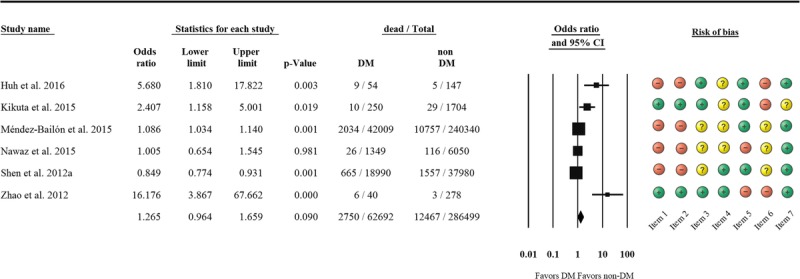
Forest plot representing the differences in mortality in DM and non-DM patients suffering from AP. Size of squares for risk ratio reflects weight of trial in pooled analysis. Horizontal bars represent 95% CIs.
FIGURE 5.
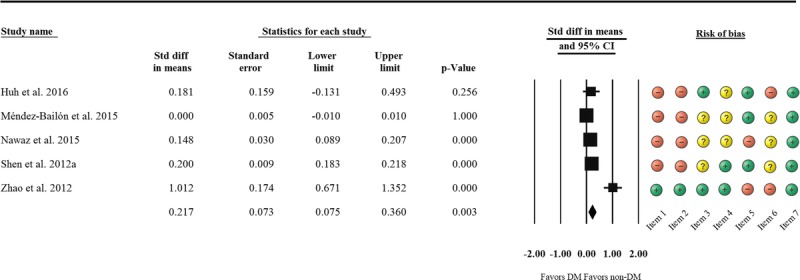
Forest plot representing the differences in LOH in DM and non-DM patients suffering from AP. Size of squares for the difference in standardized mean values reflects weight of trial in pooled analysis. Horizontal bars represent 95% CIs.
Heterogeneity and Quality Assessment of Data
High heterogeneity was detected for overall complications (Q = 25.12; DF = 6; I2 = 76.11%; P < 0.001), renal failure (Q = 10.32; DF = 3; I2 = 70.96%; P = 0.016), mortality (Q = 49.2; DF = 5; I2 = 89.84%; P < 0.001) and LOH (Q = 414.74; DF = 4; I2 = 99.03%; P < 0.001), whereas lower heterogeneity was observed for ICU admission (Q = 4.43; DF = 2; I2 = 54.84%; P = 0.11) and local complications (Q = 1.77; DF = 2; I2 = 0%; P = 0.41). To evaluate publication bias, we only made a visual assessment of the funnel plot (Supplementary Fig. 1, http://links.lww.com/MPA/A677) because we were only able to include 9 studies in our meta-analysis. According to the Cochrane Handbook,41 “tests for funnel plot asymmetry should be used only when there are at least 10 studies included in the meta-analysis, because when there are fewer studies the power of the tests is too low to distinguish chance from real asymmetry.” Articles received between 1 and 5 stars out of the maximum 7 stars on the Newcastle-Ottawa scale (Supplementary Table 4, http://links.lww.com/MPA/A663). A high risk of bias was identified in terms of the representativeness of the study population because AP patients were selected in most of the articles (Supplementary Fig. 2, http://links.lww.com/MPA/A678). The percentage of unclear risk of bias was 77.8% in the presence of outcome of interest (Supplementary Fig. 2, http://links.lww.com/MPA/A678), but cardiovascular, renal, and respiratory complications were available in only 3 or 4 articles. Body mass index data were available in only 3 articles, but unfortunately, a statistical difference was observed between DM and non-DM groups. Two articles earned only 1 star,32,35 whereas 1 article received 5 stars38 (Supplementary Table 4, http://links.lww.com/MPA/A663).
Sensitivity analysis showed no significant difference in overall and detailed complications and LOH (Supplementary Figs. 3A, B, D, http://links.lww.com/MPA/A679), whereas if we remove the Méndez-Bailon37 and Shen et al31 articles with respect to mortality, OR for mortality would change significantly from pooled OR (2.152 [95% CI, 1.063–4.358], P = 0.033 and 2.157 [95% CI, 1.165; 3.995], P = 0.014, respectively) (Supplementary Fig. 3C, http://links.lww.com/MPA/A679). Both articles involve a high number of patients and a longer follow-up time, but both articles contain data on a large patient population. We therefore included them in our meta-analysis.
Trial sequential analysis showed that in combinations and mortality the information size to achieve is 2,903,700, and these studies do not reach this yet (Supplementary Figs. 4A, B, http://links.lww.com/MPA/A680). With regard to LOH, studies reached the appropriate information size (301,416) (Supplementary Fig. 4C, http://links.lww.com/MPA/A680).
DISCUSSION AND CONCLUSIONS
In this meta-analysis, we investigated the influence of preexisting DM on different outcome parameters in AP patients. With regard to overall complications, we found significantly more complications in DM groups than in non-DM groups (Fig. 2), and higher rates of renal failure and ICU admission were also observed (Fig. 3). One quarter to half of the patients diagnosed with DM might develop chronic kidney disease, thus increasing mortality of DM.46 The development of renal failure determines the severity of AP according to the revised 2012 Atlanta Classification,3 and it raises the mortality of AP.47 The mechanism for renal failure during AP is not yet completely understood, but it has been shown that injury due to inflammatory mediators, cytokines, transcription factors, microcirculation changes, and apoptosis are important pathogenic factors.48 Development of renal failure increased the mortality of AP, suggesting that it has detrimental effects on patients with preexisting DM. The data in our meta-analysis indicated a tendency of higher mortality in DM patients (Fig. 4). It must be noted that there are data that contradict our findings. Intensive care unit mortality only grew significantly with higher mean blood glucose concentration in non-DM patients but not in DM patients.14,49 For example, Graham et al50 showed that critically ill patients with DM do not experience higher mortality compared with that seen in patients without DM. This may be explained with the beneficial antioxidant and anti-inflammatory effects of exogenous insulin used for treating hyperglycemia in DM.51,52 Insulin acts on the suppression of innate immune mechanisms and transcription factors NF-ĸB and Egr-1.52 With regard to the local complications in our analyses, DM patients tend to develop local complications more often. This is most probably due to damage to the endocrine-exocrine axis, which was discussed in detail in the background section.
Based on pooled data, diabetic AP patients spend more time in hospital (Fig. 5). This can be explained by the more intense systemic inflammatory response, more frequent complications, slower recovery, and settlement of glucose homeostasis in DM patients. The OR calculated for mortality and LOH data in Zhao et al38 differ from those in the other studies. This is clear from the mortality and LOH data, but we did not remove it because this article received the highest points on the Newcastle-Ottawa scale and the sensitivity analysis showed no difference. In cases of cardiovascular and respiratory complications, no difference was observed based on diabetic status.
Several studies have demonstrated that obesity may worsen the clinical outcome of AP.45,53,54 Diabetes mellitus patients tend to have higher body mass index, but unfortunately this data was only represented in a few articles and therefore was not suitable for data analysis.
There are several limitations of this study; therefore, the results of this meta-analysis should be regarded with caution. The greatest limitation is the low number of eligible articles included, thus causing higher heterogeneity. Second, the low amount of extracted data causes further difficulties. In addition, this meta-analysis includes mostly retrospective cohort studies. Five of 9 articles report patients from East Asia (Taiwan, Japan, Korea, and China), and only 2 present data on patients with severe AP. The Newcastle-Ottawa scale star count is unfortunately low because the data were incomplete. Trial sequential analysis showed that no sufficient data are available on this topic and further investigations are needed to show the connection between DM and complications of AP. However, despite the limitations, a notable advantage of our analysis is that it covers articles with data on patients from the last 20 years.
In summary, our meta-analysis highlights the crucial importance of the diagnosis of DM in AP patients. It is therefore highly recommended that a diagnosis be made by measuring fasting glucose and HbA1c levels on admission. The increased risk for renal failure warrants more frequent measurements of renal function parameters in AP patients also suffering from DM. Nevertheless, the high frequency of the cooccurrence of DM and AP patients suggests that further prospective high-quality cohort studies are necessary to understand the true link between AP and preexisting DM. First, an observational clinical trial would help us to understand the differences between the effects of (1) untreated preexisting diabetes with high HbA1c level and (2) well controlled, previously diagnosed diabetes. Second, the local mechanisms behind the harmful effects of preexisting diabetes need in depth scrutiny. Therefore, another trial should be performed in which the levels of insulin, C-peptide, and glucagon are measured in patients with AP and DM. It is needless to say that further interventional studies should be performed to identify the best treatment options of diabetes during AP.
In conclusion, our systematic review and meta-analysis clearly shows that preexisting DM negatively influences AP outcomes by raising the incidence of renal failure, ICU admission, and LOH and leads to a tendency of higher mortality.
Supplementary Material
ACKNOWLEDGMENTS
The present scientific contribution is dedicated to the 650th anniversary of the founding of the University of Pécs, Hungary.
Footnotes
P.H. and L.C. contributed equally to this article.
This study was supported by Project Grants (K116634 and KH125678 to P.H.) and Economic Development and Innovation Operative Programme Grant (GINOP 2.3.2-15-2016-00048 to P.H.) and Human Resources Development Operational Programme Grant (EFOP-3.6.2-16-2017-00006 to P.H.) of the National Research, Development and Innovation Office and by a Momentum Grant of the Hungarian Academy of Sciences (LP2014-10/2014 to P.H.). The authors declare no conflict of interest.
Supplemental digital contents are available for this article. Direct URL citations appear in the printed text and are provided in the HTML and PDF versions of this article on the journal’s Web site (www.pancreasjournal.com).
REFERENCES
- 1.Rebours V. [Acute pancreatitis: an overview of the management]. [Article in French]. Rev Med Interne. 2014;35:649–655. [DOI] [PubMed] [Google Scholar]
- 2.Fagenholz PJ, Castillo CF, Harris NS, et al. Increasing United States hospital admissions for acute pancreatitis, 1988-2003. Ann Epidemiol. 2007;17:491–497. [DOI] [PubMed] [Google Scholar]
- 3.Banks PA, Bollen TL, Dervenis C, et al. Classification of acute pancreatitis—2012: revision of the Atlanta classification and definitions by international consensus. Gut. 2013;62:102–111. [DOI] [PubMed] [Google Scholar]
- 4.WHO Press, Global report on diabetes. Geneva, Switzerland; 2016. [Google Scholar]
- 5.Vujasinovic M, Tepes B, Makuc J, et al. Pancreatic exocrine insufficiency, diabetes mellitus and serum nutritional markers after acute pancreatitis. World J Gastroenterol. 2014;20:18432–18438. [DOI] [PMC free article] [PubMed] [Google Scholar]
- 6.Xue Y, Sheng Y, Dai H, et al. Risk of development of acute pancreatitis with pre-existing diabetes: a meta-analysis. Eur J Gastroenterol Hepatol. 2012;24:1092–1098. [DOI] [PubMed] [Google Scholar]
- 7.Yang L, He Z, Tang X, et al. Type 2 diabetes mellitus and the risk of acute pancreatitis: a meta-analysis. Eur J Gastroenterol Hepatol. 2013;25:225–231. [DOI] [PubMed] [Google Scholar]
- 8.Urushihara H, Taketsuna M, Liu Y, et al. Increased risk of acute pancreatitis in patients with type 2 diabetes: an observational study using a Japanese hospital database. PloS One. 2012;7:e53224. [DOI] [PMC free article] [PubMed] [Google Scholar]
- 9.Girman CJ, Kou TD, Cai B, et al. Patients with type 2 diabetes mellitus have higher risk for acute pancreatitis compared with those without diabetes. Diabetes Obes Metab. 2010;12:766–771. [DOI] [PubMed] [Google Scholar]
- 10.Lai SW, Muo CH, Liao KF, et al. Risk of acute pancreatitis in type 2 diabetes and risk reduction on anti-diabetic drugs: a population-based cohort study in taiwan. Am J Gastroenterol. 2011;106:1697–1704. [DOI] [PubMed] [Google Scholar]
- 11.Gonzalez-Perez A, Schlienger RG, García Rodríguez LA. Acute pancreatitis in association with type 2 diabetes and antidiabetic drugs: a population-based cohort study. Diabetes Care. 2010;33:2580–2585. [DOI] [PMC free article] [PubMed] [Google Scholar]
- 12.Aune D, Vatten LJ. Diabetes mellitus and the risk of gallbladder disease: a systematic review and meta-analysis of prospective studies. J Diabetes Complications. 2016;30:368–373. [DOI] [PubMed] [Google Scholar]
- 13.Laakso M. Lipid disorders in type 2 diabetes. Endocrinol Nutr. 2009; 56 Suppl 4:43–45. [PubMed] [Google Scholar]
- 14.Egi M, Bellomo R, Stachowski E, et al. Blood glucose concentration and outcome of critical illness: the impact of diabetes. Crit Care Med. 2008;36:2249–2255. [DOI] [PubMed] [Google Scholar]
- 15.Frey C, Zhou H, Harvey D, et al. Co-morbidity is a strong predictor of early death and multi-organ system failure among patients with acute pancreatitis. J Gastrointest Surg. 2007;11:733–742. [DOI] [PubMed] [Google Scholar]
- 16.Premkumar R, Phillips AR, Petrov MS, et al. The clinical relevance of obesity in acute pancreatitis: targeted systematic reviews. Pancreatology. 2015;15:25–33. [DOI] [PubMed] [Google Scholar]
- 17.Singh S, Chang HY, Richards TM, et al. Glucagonlike peptide 1-based therapies and risk of hospitalization for acute pancreatitis in type 2 diabetes mellitus: a population-based matched case-control study. JAMA Intern Med. 2013;173:534–539. [DOI] [PubMed] [Google Scholar]
- 18.Knapen LM, de Jong RG, Driessen JH, et al. Use of incretin agents and risk of acute and chronic pancreatitis: a population-based cohort study. Diabetes Obes Metab. 2017;19:401–411. [DOI] [PubMed] [Google Scholar]
- 19.Li L, Shen J, Bala MM, et al. Incretin treatment and risk of pancreatitis in patients with type 2 diabetes mellitus: systematic review and meta-analysis of randomised and non-randomised studies. BMJ. 2014;348:g2366. [DOI] [PMC free article] [PubMed] [Google Scholar]
- 20.Goodger RL, Asrani VM, Windsor JA, et al. Impact of metabolic comorbidities on outcomes of patients with acute pancreatitis: a scoping review. Panminerva Med. 2016;58:86–93. [PubMed] [Google Scholar]
- 21.Monami M, Dicembrini I, Nardini C, et al. Glucagon-like peptide-1 receptor agonists and pancreatitis: a meta-analysis of randomized clinical trials. Diabetes Res Clin Pract. 2014;103:269–275. [DOI] [PubMed] [Google Scholar]
- 22.Zechner D, Spitzner M, Müller-Graff T, et al. Diabetes increases pancreatitis induced systemic inflammation but has little effect on inflammation and cell death in the lung. Int J Exp Pathol. 2014;95:411–417. [DOI] [PMC free article] [PubMed] [Google Scholar]
- 23.Zechner D, Knapp N, Bobrowski A, et al. Diabetes increases pancreatic fibrosis during chronic inflammation. Exp Biol Med (Maywood). 2014;239:670–676. [DOI] [PubMed] [Google Scholar]
- 24.Zechner D, Spitzner M, Bobrowski A, et al. Diabetes aggravates acute pancreatitis and inhibits pancreas regeneration in mice. Diabetologia. 2012;55:1526–1534. [DOI] [PubMed] [Google Scholar]
- 25.Hegyi P, Takács T, Tiszlavicz L, et al. Recovery of exocrine pancreas six months following pancreatitis induction with L-arginine in streptozotocin-diabetic rats. J Physiol Paris. 2000;94:51–55. [DOI] [PubMed] [Google Scholar]
- 26.Hegyi P, Czako L, Takacs T, et al. Pancreatic secretory responses in L-arginine-induced pancreatitis: comparison of diabetic and nondiabetic rats. Pancreas. 1999;19:167–174. [DOI] [PubMed] [Google Scholar]
- 27.Hegyi P, Rakonczay Z, Jr, Sari R, et al. Insulin is necessary for the hypertrophic effect of cholecystokinin-octapeptide following acute necrotizing experimental pancreatitis. World J Gastroenterol. 2004;10:2275–2277. [DOI] [PMC free article] [PubMed] [Google Scholar]
- 28.Takács T, Hegyi P, Jármay K, et al. Cholecystokinin fails to promote pancreatic regeneration in diabetic rats following the induction of experimental pancreatitis. Pharmacol Res. 2001;44:363–372. [DOI] [PubMed] [Google Scholar]
- 29.Moher D, Liberati A, Tetzlaff J, et al. Preferred reporting items for systematic reviews and meta-analyses: the PRISMA statement. PLoS Med. 2009;6:e1000097. [DOI] [PMC free article] [PubMed] [Google Scholar]
- 30.Kikuta K, Masamune A, Shimosegawa T. Impaired glucose tolerance in acute pancreatitis. World J Gastroenterol. 2015;21:7367–7374. [DOI] [PMC free article] [PubMed] [Google Scholar]
- 31.Shen HN, Lu CL, Li CY. Effect of diabetes on severity and hospital mortality in patients with acute pancreatitis: a national population-based study. Diabetes Care. 2012;35:1061–1066. [DOI] [PMC free article] [PubMed] [Google Scholar]
- 32.Shen HN, Chang YH, Chen HF, et al. Increased risk of severe acute pancreatitis in patients with diabetes. Diabet Med. 2012;29:1419–1424. [DOI] [PubMed] [Google Scholar]
- 33.Kumar R, Pahwa N, Jain N. Acute kidney injury in severe acute pancreatitis: an experience from a tertiary care center. Saudi J Kidney Dis Transpl. 2015;26:56–60. [DOI] [PubMed] [Google Scholar]
- 34.Mole DJ, Gungabissoon U, Johnston P, et al. Identifying risk factors for progression to critical care admission and death among individuals with acute pancreatitis: a record linkage analysis of Scottish healthcare databases. BMJ Open. 2016;6:e011474. [DOI] [PMC free article] [PubMed] [Google Scholar]
- 35.Nawaz H, O'Connell M, Papachristou GI, et al. Severity and natural history of acute pancreatitis in diabetic patients. Pancreatology. 2015;15:247–252. [DOI] [PubMed] [Google Scholar]
- 36.Huh JH, Jeon H, Park SM, et al. Diabetes mellitus is associated with mortality in acute pancreatitis. J Clin Gastroenterol. 2018;52:178–183. [DOI] [PubMed] [Google Scholar]
- 37.Méndez-Bailón M, de Miguel Yanes JM, Jiménez-García R, et al. National trends in incidence and outcomes of acute pancreatitis among type 2 diabetics and non-diabetics in Spain (2001–2011). Pancreatology. 2015;15:64–70. [DOI] [PubMed] [Google Scholar]
- 38.Zhao X, Chang Mei H, Chen L, et al. An increased level of haemoglobin A1C predicts a poorer clinical outcome in patients with acute pancreatitis. Clin Endocrinol (Oxf). 2012;77:241–245. [DOI] [PubMed] [Google Scholar]
- 39.DerSimonian R, Laird N. Meta-analysis in clinical trials. Control Clin Trials. 1986;7:177–188. [DOI] [PubMed] [Google Scholar]
- 40.Hozo SP, Djulbegovic B, Hozo I. Estimating the mean and variance from the median, range, and the size of a sample. BMC Med Res Methodol. 2005;5:13. [DOI] [PMC free article] [PubMed] [Google Scholar]
- 41.Higgins JPT, Green S, eds. Cochrane Handbook for Systematic Reviews of Interventions. Version 5.1.0(updated 2011). The Cochrane Collaboration; 2011. Available at: http://handbook.cochrane.org. Accessed April 30, 2017. [Google Scholar]
- 42.Viel JF, Pobel D, Carre A. Incidence of leukaemia in young people around the La Hague nuclear waste reprocessing plant: a sensitivity analysis. Stat Med. 1995;14:2459–2472. [DOI] [PubMed] [Google Scholar]
- 43.Wells GA, Shea B, O'Connell D, et al. The Newcastle-Ottawa scale (NOS) for assessing the quality of nonrandomised studies in meta-analyses. 2011. Available at http://www.ohri.ca/programs/clinical_epidemiology/oxford.asp. Accessed April 30, 2017. [Google Scholar]
- 44.American Diabetes Association. Standards of medical care in diabetes—2010. Diabetes Care. 2010;33(suppl 1):S11–S61. [DOI] [PMC free article] [PubMed] [Google Scholar]
- 45.Krishna SG, Hinton A, Oza V, et al. Morbid obesity is associated with adverse clinical outcomes in acute pancreatitis: a propensity-matched study. Am J Gastroenterol. 2015;110:1608–1619. [DOI] [PubMed] [Google Scholar]
- 46.Radcliffe NJ, Seah JM, Clarke M, et al. Clinical predictive factors in diabetic kidney disease progression. J Diabetes Investig. 2017;8:6–18. [DOI] [PMC free article] [PubMed] [Google Scholar]
- 47.Lin HY, Lai JI, Lai YC, et al. Acute renal failure in severe pancreatitis: a population-based study. Ups J Med Sci. 2011;116:155–159. [DOI] [PMC free article] [PubMed] [Google Scholar]
- 48.Zhang XP, Wang L, Zhou YF. The pathogenic mechanism of severe acute pancreatitis complicated with renal injury: a review of current knowledge. Dig Dis Sci. 2008;53:297–306. [DOI] [PubMed] [Google Scholar]
- 49.Whitcomb BW, Pradhan EK, Pittas AG, et al. Impact of admission hyperglycemia on hospital mortality in various intensive care unit populations. Crit Care Med. 2005;33:2772–2777. [DOI] [PubMed] [Google Scholar]
- 50.Graham BB, Keniston A, Gajic O, et al. Diabetes mellitus does not adversely affect outcomes from a critical illness. Crit Care Med. 2010;38:16–24. [DOI] [PubMed] [Google Scholar]
- 51.Garg R, Chaudhuri A, Munschauer F, et al. Hyperglycemia, insulin, and acute ischemic stroke: a mechanistic justification for a trial of insulin infusion therapy. Stroke. 2006;37:267–273. [DOI] [PubMed] [Google Scholar]
- 52.Sun Q, Li J, Gao F. New insights into insulin: The anti-inflammatory effect and its clinical relevance. World J Diabetes. 2014;5:89–96. [DOI] [PMC free article] [PubMed] [Google Scholar]
- 53.Yoon SB, Choi MH, Lee IS, et al. Impact of body fat and muscle distribution on severity of acute pancreatitis. Pancreatology. 2017;17:188–193. [DOI] [PubMed] [Google Scholar]
- 54.Jin Z, Xu L, Wang X, et al. Risk factors for worsening of acute pancreatitis in patients admitted with mild acute pancreatitis. Med Sci Monit. 2017;23:1026–1032. [DOI] [PMC free article] [PubMed] [Google Scholar]
Associated Data
This section collects any data citations, data availability statements, or supplementary materials included in this article.


